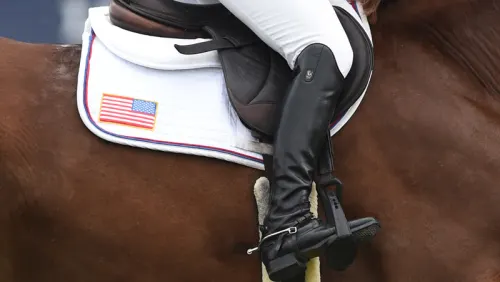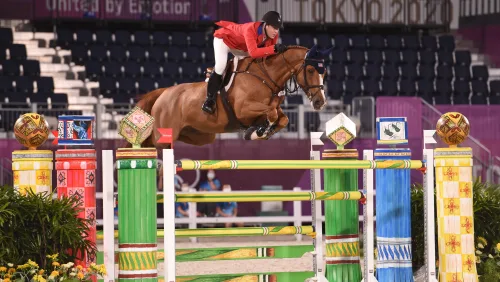The final day of the 2023 USEF Horsemastership Training Series had more of a show-ring feel than the flatwork and gymnastics sessions that preceded it, as the dozen young riders involved sought to put together everything they’d learned.
Olympic show jumper Kent Farrington, who was leading the Sunday session in Wellington, Florida, started the session by asking each participant to walk a course and school their horses on their own, then tell Farrington their plan for jumping the course and head into the ring.
“For today, I’m being your chef d’equipe for a Nations Cup class: Walk up to the gate, and briefly tell me your plan,” he said as Luke Jensen walked a circle around him. When Jensen tried to get too technical with his plan, Farrington shook his head and told him something he would repeat to others: “I want a quick review for yourself—don’t make it a science project.”

Alexa Leong (background) listens to Kent Farrington lecture during the Sunday jumping session that concluded the 2023 USEF Horsemastership Training Series in Wellington, Fla. Taylor Pence Photo
Sunday’s ring was divided by green gates, with a warm-up area that had three schooling jumps and people to set them on one side and a carefully constructed 1.25-1.30-meter course on the other. Continuing his Nations Cup approach, Farrington wanted to teach riders how to contribute a positive score to a hypothetical team. He focused on efficiency and using the track to improve speed rather than arbitrarily running around the course. While not all of the participating riders will ride on a team in the future, the skills help in the regular horse show ring as well, where courses are increasingly technical and speed-focused.
Jensen and Alexa Leong went first and second, starting the day off with several time faults and rails. “We know the time is short,” Farrington said. “But you should be formulating a plan: How do I complete this without being erratic? Where can I take time off?”
When it was Jake Endicott’s turn, he and his borrowed mount ran into trouble early on. They had the back rail down at Fence 2, and when he didn’t react and get the seven strides to Fence 3, his horse lost a bit of confidence, refusing Fence 4 four strides later. After a circle to jump Fence 4, they had another rail down at Fence 5B.
“When you turned to Fence 2 and had the rail, you needed to switch gears faster,” Farrington said. “When you feel like you’re in trouble, instantly switch into a bit of defensive mode or overriding: How do I keep this round alive? Your horse needed confidence because he lost it. Give him a cluck of encouragement, ride with more pace. Instantly switch this into ‘How do I salvage this round? Can I pull this together so we can get a halfway useful score for my team, or do I need to retire because this isn’t going to work?’ ”
Although Corinne Sweeney jumped clean, she notched 7 time faults, leading Farrington to talk about the rapid decision-making needed on course.
“At the start, you got stuck at Fence 2 and did an extra stride up to Fence 3,” he said. “Right away, you needed to know that you were behind the clock.
“I would have tried to make up time without a high level of risk,” he continued, suggesting a few places in the track where she could have done so.
Farrington was also quick to applaud riders for their good horsemanship. When Trent McGee started his round, he allowed his borrowed horse to trot past a liverpool on course before he started his round.
ADVERTISEMENT
“He doesn’t know this horse, so that was a smart move,” Farrington said. “Now he knows what the horse will do when they come to it. I would let them see it too, so it’s not a total shock the first time.”
McGee was thrilled about the opportunity to work with Farrington.
“Kent has been my idol since I was a kid,” McGee said. “To hear his analysis of every round, including my own, was extremely insightful. Being able to also pick his brain a little bit after the riding was over was an amazing opportunity and learning experience.”
Farrington reminded riders repeatedly to keep their course plans simple for best results.
“Your course plans are taking up too much time,” Farrington said. “It’s not an exam that we’re trying to take. Your plan should take less than 20 seconds. Realistically, you’re not going to do everything you say anyway, and trying to jam so much information in will only discourage you when you don’t complete a step.
“Brief, concise, realistic,” he added. “Simplify the lines: How do I make the course as easy as I can for the horse?”
Although Farrington remained mostly quiet as the riders schooled themselves in the warm-up ring, he did offer some general advice: “I see a lot of people jumping a lot of jumps. Keep the efforts out here at a minimum. Every jump counts. If the horse is slow to the first warm-up fence, I land and send the horse forward. If they’re bold to it, I’m more patient and make them wait.”
Before the riders tackled the course a second time, Farrington took a more involved approach. He went over each rider’s schooling plan with them, giving them tips on what he felt would help their warm-up and outlining how to complete the warm-up in four or five jumps. Then he helped them formulate an effective plan for the ring, advising where to shave off time, how to make improvements in their position, and which corners to accelerate or turn tighter through.
Farrington also reminded the riders how important it is to give the horses breaks in the schooling ring.
“Let them walk for a second,” Farrington said. “I like that. I like to let the horse catch his breath and regroup. I see riders just jump, jump, jump, jump and then go in.
“Your last jump should be realistic ring tempo so you’re showing them what’s to come in the ring,” he added. “I’m awake on the horse—he’s not on a loose rein on the way to the gate; I’m testing him to see if he’s ahead of my leg and responsive before I enter the ring without taking too much of his energy. I push him forward into a bigger walk, then do a small transition to the trot. I always make sure he’s marching at the walk.”
ADVERTISEMENT
Farrington talked at length about seeing horses as athletes and taking the same care with their work and recovery that successful human athletes get.
“Reducing the wear and tear on the athlete is optimal. Professional athletes are aware of these details,” he said. “I’m aware of that on all of my horses, and that’s how you get the most out of your athletes. All the jumps in your warm-up matter; don’t waste the horse’s energy.”
Although Endicott’s first round did not go as he planned, Farrington showed him how to regroup by starting his warm-up with a small 3’3” vertical before jumping fences at the course height.
“For me, every jump in the warm-up for this horse should be about confidence, because you struggled in the first round,” Farrington said. “We’re doing this to help the horse, so he carries his own canter. I want both of you to go in more confident. If we were doing a Nations Cup, your team is relying on you, and you need to put in a result that you can use.”
For the last warm-up fence, Farrington lowered it to 3’6” and again explained that he wanted the horse to feel confident heading into the ring.
Endicott went in and laid down a brilliant round with only a slight rub on the back rail of Fence 10.
“Excellent. Massive recovery. Super round,” Farrington complimented him. “This is a good example of not giving up. If you have struggle in the first round, you don’t know the score of the game yet. Even if it’s an ugly round but you can salvage it somehow, that could be the difference between first and nothing. In show jumping, crazy things can happen. Always strive to be a contributing score for your team.”
Asked how he handles a rough day mentally himself, Farrington pointed out that good and bad days are a part of the game.
“I think we’re all human, and no one is happy about a bad day or round,” he said. “You have to be willing to be down for a moment, and that is OK. Over the years, I have learned to put that behind me and channel my energy forward into the next task.”
Farrington also reminded the riders how important it is for them to work on the mental skills necessary to remain calm under pressure.
“Horses like consistency and a method,” he said. “I always approach every class as a serious endeavor, so that when it’s a big class, it’s not any different for me than a normal class. I try to approach everything the same: calm and cool under pressure. Horses really thrive under that.”
Farrington’s session concluded the three-day clinic, held Jan. 6-8. For coverage of the first two days, flatwork with Anne Kursinski and gymnastics with McLain Ward, click here. USEF members can watch all sessions on demand via USEF Network.














